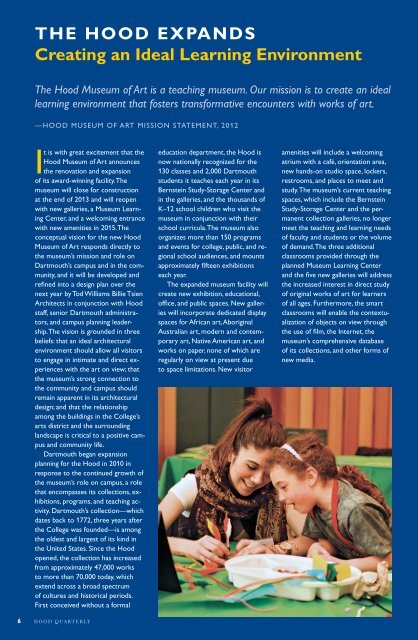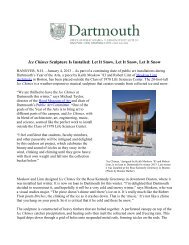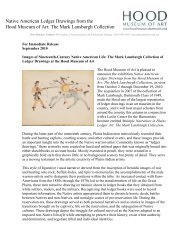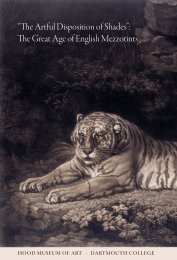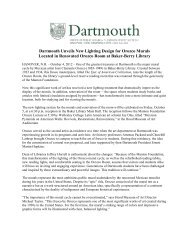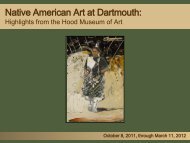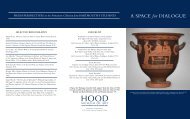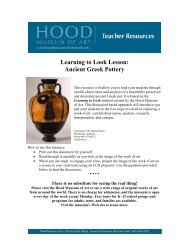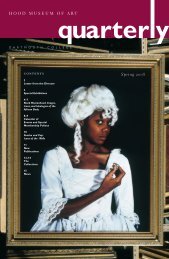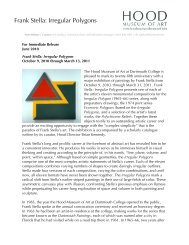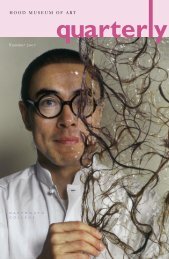Fall 2012 - Hood Museum of Art - Dartmouth College
Fall 2012 - Hood Museum of Art - Dartmouth College
Fall 2012 - Hood Museum of Art - Dartmouth College
Create successful ePaper yourself
Turn your PDF publications into a flip-book with our unique Google optimized e-Paper software.
The <strong>Hood</strong> Expands<br />
Creating an Ideal Learning Environment<br />
The <strong>Hood</strong> <strong>Museum</strong> <strong>of</strong> <strong>Art</strong> is a teaching museum. Our mission is to create an ideal<br />
learning environment that fosters transformative encounters with works <strong>of</strong> art.<br />
—<strong>Hood</strong> <strong>Museum</strong> <strong>of</strong> <strong>Art</strong> mission statement, <strong>2012</strong><br />
It is with great excitement that the<br />
<strong>Hood</strong> <strong>Museum</strong> <strong>of</strong> <strong>Art</strong> announces<br />
the renovation and expansion<br />
<strong>of</strong> its award-winning facility. The<br />
museum will close for construction<br />
at the end <strong>of</strong> 2013 and will reopen<br />
with new galleries, a <strong>Museum</strong> Learning<br />
Center, and a welcoming entrance<br />
with new amenities in 2015. The<br />
conceptual vision for the new <strong>Hood</strong><br />
<strong>Museum</strong> <strong>of</strong> <strong>Art</strong> responds directly to<br />
the museum’s mission and role on<br />
<strong>Dartmouth</strong>’s campus and in the community,<br />
and it will be developed and<br />
refined into a design plan over the<br />
next year by Tod Williams Billie Tsien<br />
Architects in conjunction with <strong>Hood</strong><br />
staff, senior <strong>Dartmouth</strong> administrators,<br />
and campus planning leadership.<br />
The vision is grounded in three<br />
beliefs: that an ideal architectural<br />
environment should allow all visitors<br />
to engage in intimate and direct experiences<br />
with the art on view; that<br />
the museum’s strong connection to<br />
the community and campus should<br />
remain apparent in its architectural<br />
design; and that the relationship<br />
among the buildings in the <strong>College</strong>’s<br />
arts district and the surrounding<br />
landscape is critical to a positive campus<br />
and community life.<br />
<strong>Dartmouth</strong> began expansion<br />
planning for the <strong>Hood</strong> in 2010 in<br />
response to the continued growth <strong>of</strong><br />
the museum’s role on campus, a role<br />
that encompasses its collections, exhibitions,<br />
programs, and teaching activity.<br />
<strong>Dartmouth</strong>’s collection—which<br />
dates back to 1772, three years after<br />
the <strong>College</strong> was founded—is among<br />
the oldest and largest <strong>of</strong> its kind in<br />
the United States. Since the <strong>Hood</strong><br />
opened, the collection has increased<br />
from approximately 47,000 works<br />
to more than 70,000 today, which<br />
extend across a broad spectrum<br />
<strong>of</strong> cultures and historical periods.<br />
First conceived without a formal<br />
education department, the <strong>Hood</strong> is<br />
now nationally recognized for the<br />
130 classes and 2,000 <strong>Dartmouth</strong><br />
students it teaches each year in its<br />
Bernstein Study-Storage Center and<br />
in the galleries, and the thousands <strong>of</strong><br />
K–12 school children who visit the<br />
museum in conjunction with their<br />
school curricula. The museum also<br />
organizes more than 150 programs<br />
and events for college, public, and regional<br />
school audiences, and mounts<br />
approximately fifteen exhibitions<br />
each year.<br />
The expanded museum facility will<br />
create new exhibition, educational,<br />
<strong>of</strong>fice, and public spaces. New galleries<br />
will incorporate dedicated display<br />
spaces for African art, Aboriginal<br />
Australian art, modern and contemporary<br />
art, Native American art, and<br />
works on paper, none <strong>of</strong> which are<br />
regularly on view at present due<br />
to space limitations. New visitor<br />
amenities will include a welcoming<br />
atrium with a café, orientation area,<br />
new hands-on studio space, lockers,<br />
restrooms, and places to meet and<br />
study. The museum’s current teaching<br />
spaces, which include the Bernstein<br />
Study-Storage Center and the permanent<br />
collection galleries, no longer<br />
meet the teaching and learning needs<br />
<strong>of</strong> faculty and students or the volume<br />
<strong>of</strong> demand. The three additional<br />
classrooms provided through the<br />
planned <strong>Museum</strong> Learning Center<br />
and the five new galleries will address<br />
the increased interest in direct study<br />
<strong>of</strong> original works <strong>of</strong> art for learners<br />
<strong>of</strong> all ages. Furthermore, the smart<br />
classrooms will enable the contextualization<br />
<strong>of</strong> objects on view through<br />
the use <strong>of</strong> film, the Internet, the<br />
museum’s comprehensive database<br />
<strong>of</strong> its collections, and other forms <strong>of</strong><br />
new media.<br />
6 HOOD QUARTERLY


